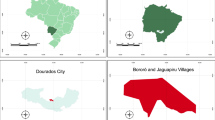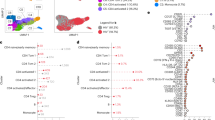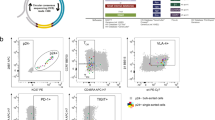Abstract
The worldwide geographic and ethnic clustering of patients with diseases related to human T-cell lymphotropic virus type I (HTLV-I) may be explained by the natural history of HTLV-I infection1,2. The genetic characteristics of indigenous people in the Andes are similar to those of the Japanese3,4, and HTLV-I is generally detected in both groups5. To clarify the common origin of HTLV-I in Asia and the Andes, we analyzed HTLV-I provirus DNA from Andean mummies about 1,500 years old. Two of 104 mummy bone marrow specimens yielded a band of human β-globin gene DNA 110 base pairs in length, and one of these two produced bands of HTLV-I-pX (open reading frame encoding p40x, p27x) and HTLV-I-LTR (long terminal repeat) gene DNA 159 base pairs and 157 base pairs in length, respectively. The nucleotide sequences of ancient HTLV-I-pX and HTLV-I-LTR clones isolated from mummy bone marrow were similar to those in contemporary Andeans and Japanese, although there was microheterogeneity in the sequences of some mummy DNA clones. This result provides evidence that HTLV-I was carried with ancient Mongoloids to the Andes before the Colonial era. Analysis of ancient HTLV-I sequences could be a useful tool for studying the history of human retroviral infection as well as human prehistoric migration.
This is a preview of subscription content, access via your institution
Access options
Subscribe to this journal
Receive 12 print issues and online access
$209.00 per year
only $17.42 per issue
Buy this article
- Purchase on Springer Link
- Instant access to full article PDF
Prices may be subject to local taxes which are calculated during checkout





Similar content being viewed by others
References
Tajima, K. & Hinuma, Y. Epidemiology of HTLV-I/II in Japan and the world. Gan Monogr. Cancer Res. 39, 129–149 (1992).
Tajima, K. HTLV-I/II related disease with special reference to its distribution among Mongoloids. Gan Monogr. Cancer Res. 44, 123–135 (1996).
Sonoda, S. & Fujiyoshi, T. HTLV-I infection and HLA. Gan Monogr. Cancer Res. 44, 207–217 (1996).
Horai, S., Kondo, R., Sonoda, S. & Tajima, K. in Prehistoric Mongoloid Dispersal. (eds. Akazawa, T. & Szathmary, E.T.E.) 270–283 (Oxford University Press, New York, 1996).
Fujiyoshi, T. et al. Characteristic distribution of HTLV type I and HTLV type II carriers among native ethnic groups in South America. AIDS Res. Hum. Retroviruses 15, 1235–1239 (1999).
Shimotohno, K. et al. Complete nucleotide sequence of an infectious clone of human T-cell leukemia virus type II: A open reading frame for the protease gene. Proc. Natl. Acad. Sci. USA 82, 3101– 3105 (1985).
Fullerton, S.M., Harding, R.M., Boyce, A.J. & Clegg, J.B. Molecular and population genetic analysis of allelic sequence diversity at the human beta-globin locus. Proc. Natl. Acad. Sci. USA 91, 1805–1809 (1994).
Miura, T. et al. Phylogenetic subtypes of human T-lymphotropic virus type I and their relations to the anthropological background. Proc. Natl. Acad. Sci. USA 91, 1124–1127 (1994).
Seiki, M., Hattori, S., Hirayama, Y. & Yoshida, M. Human adult T-cell leukemia virus: Complete nucleotide sequence of the provirus genome integrated in leukemia cell DNA. Proc. Natl. Acad. Sci. USA 80, 3618–3622 (1983).
Miura, T. et al. Molecular phylogeny of human T-cell leukemia virus type I and II of Amerindians in Colombia and Chile. J. Mol. Evol. 44, S76–82 (1997).
Watanabe, T., Seiki, M. & Yoshida, M. HTLV type I (USA isolate) and ATLV (Japanese isolated) are the same species of human retrovirus. Virology 133, 238–241 (1984).
Yamashita, M. et al. HTLV-Is in Argentina are phylogenetically similar to those of other South American countries, but different from HTLV-Is in Africa. J. Med. Virol. 55, 152–160 (1998).
Saito, M. et al. Mutation rates in LTR of HTLV-1 in HAM/TSP patients and the carriers are similarly high to Tax/Rex-coding sequence. J. Neurovirol. 2, 330–335 (1996).
Niewiesk, S. et al. The transactivator gene of human T-cell leukemia virus type I is more variable within and between healthy carriers than patients with tropical spastic paraparesis. J. Virol. 68, 6778–6781 (1994).
Krings, M. et al. Neandertal DNA sequences and the origin of modern humans. Cell 90, 19–30 (1997).
Yoshida, M., Inoue, J., Fujisawa, J. & Seiki, M. Molecular mechanisms of regulation of HTLV-I gene expression and its association with leukemogenesis. Genome 31, 662–667 (1989).
Thomas, W.K. & Pääbo, S. DNA sequences from old tissue remains. Methods Enzymol. 224, 406– 419 (1993).
Cano, R.J. & Poinär, H.N. Rapid isolation of DNA from fossil and museum specimens suitable for PCR. BioTechniques 15, 432–436 (1993).
Saiki, R.K. et al. Primer-directed enzymatic amplification of DNA with a thermostable DNA polymerase. Science 239, 487– 491 (1988).
Kwok, S., Ehrlich, G., Poiesz, B., Kalish, R. & Sninsky, J.J. Enzymatic amplification of HTLV-I viral sequences from peripheral blood mononuclear cells and infected tissues. Blood 72, 1117–1123 (1988).
Handt, O., Krings, M., Ward R.H. & Pääbo, S . The retrieval of ancient human DNA sequences. Am. J. Hum. Genet. 59, 368–376 (1996).
Andres, D.A. et al. cDNA cloning of component A of Rab geranylgeranyl transferase and demonstration of its role as a Rab escort protein. Cell 73, 1091–1099 (1993).
Acknowledgements
This work was supported by Grants-in-Aid from the Mombusho International Scientific Research Program and a Research Grant from the Princess Takamatsu Cancer Research Fund.
Author information
Authors and Affiliations
Corresponding author
Rights and permissions
About this article
Cite this article
Li, HC., Fujiyoshi, T., Lou, H. et al. The presence of ancient human T-cell lymphotropic virus type I provirus DNA in an Andean mummy. Nat Med 5, 1428–1432 (1999). https://doi.org/10.1038/71006
Received:
Accepted:
Issue Date:
DOI: https://doi.org/10.1038/71006
This article is cited by
-
Role of Exosomes in Human Retroviral Mediated Disorders
Journal of Neuroimmune Pharmacology (2018)
-
Seroprevalence of human T-cell lymphotropic virus type 1 and 2 in blood donors from the regional hospital of Valdivia, Chile
Medical Microbiology and Immunology (2010)
-
Presence of Helicobacter pylori in a Mexican Pre-Columbian Mummy
BMC Microbiology (2008)
-
Palaeomicrobiology: current issues and perspectives
Nature Reviews Microbiology (2005)



